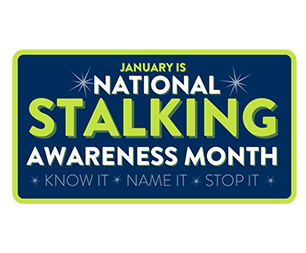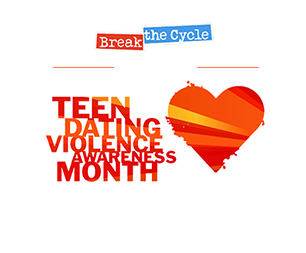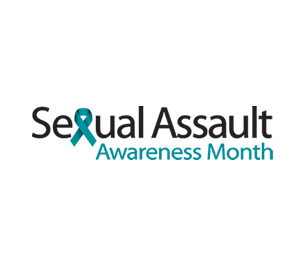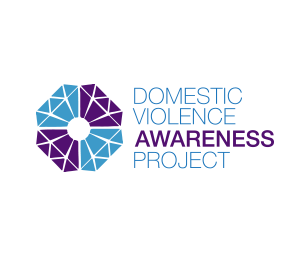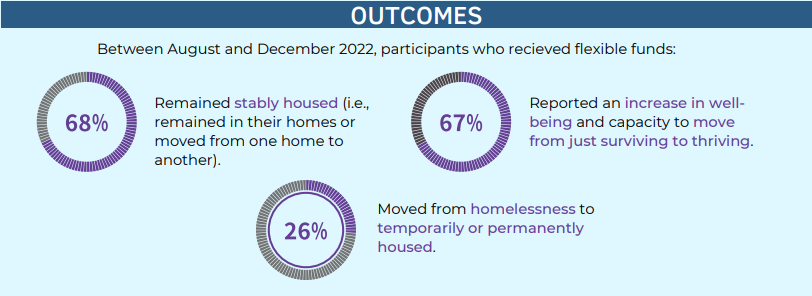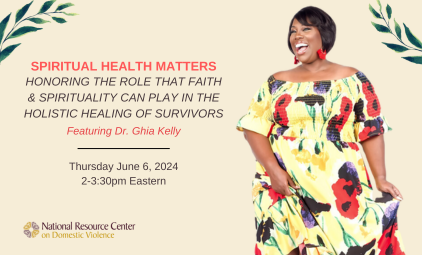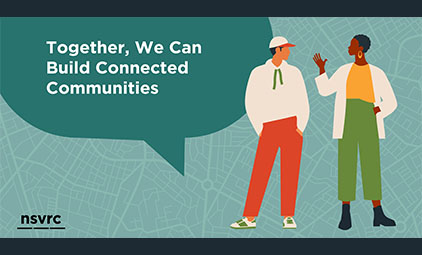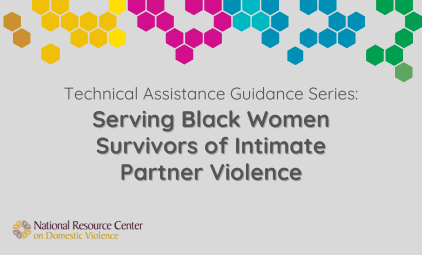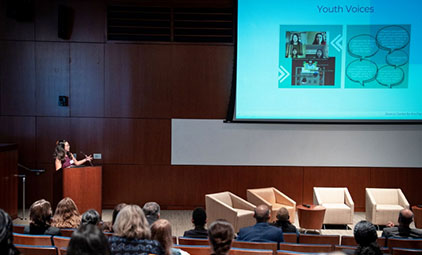By Marlena Moore, Senior Program Specialist
“Funding has helped me tremendously (…). I’ve been able to make ends meet in my rough patch with groceries and my rent. I am very appreciative to have this program in my corner.” – Survivor
Domestic violence impacts survivors in many ways, including their economic stability. Survivors experience economic challenges that can include loss of income, damaged property, and/or coerced debt. These challenges can take many forms which also threatens survivors’ safety and housing stability. Lacking economic stability makes it harder for survivors to obtain new housing that they have identified as safe and affordable or maintain their current housing. This could be due to credit scores, unpaid housing related bills, or prior eviction notices that impact down payments. Economic insecurity and housing insecurity can also make survivors vulnerable to more violence.
Flexible financial assistance is an innovative practice that has shown increasing popularity across the country within the last decade. The practice of flexible funding includes providing specific amounts of financial assistance to survivors. This direct cash assistance can support their ability to obtain or maintain safe, stable housing. A previous TA Question of the Month from 2018 provided an overview of the Victims of Crime Act (VOCA) regulations that supported funding to be used for housing-related needs and how a few organizations had embedded some form of flexible funding into their programs. It provided the structure under which programs could develop flexible funding programs to support survivors in their communities.
There are programs that provide monetary aid to survivors that have stipulations on what funding looks like. This could be restrictions on how much survivors can ask for to save funds for unforeseen emergencies. Other stipulations require survivors to identify specifically what they are using funds for to quantify who should get funding or get access to funds first. These practices show a distinct lack of trust between programs and survivors when advocacy models center on believing survivors. This TAQ focuses on how flexible financial assistance can be equitably distributed to survivors of intimate partner violence.
Working to Support Survivors Where They Are
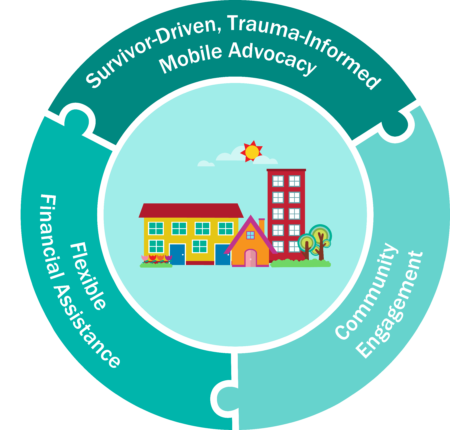 The Washington State Coalition Against Domestic Violence, with support from the Bill & Melinda Gates Foundation, launched their Domestic Violence Housing First (DVHF) demonstration project in 2015, which closed out in 2019. Working with direct service programs across the state, the project was able to identify the positive impact that DVHF has on survivors compared to what is identified as “services as usual.” The toolkit developed from this project notes that accessing or maintaining safe and stable housing for survivors is at its core with its key components being survivor-driven, trauma-informed mobile advocacy; flexible financial assistance; and community engagement. The section on flexible financial assistance has provided examples of what direct cash assistance looks like for survivors which includes but is not limited to moving expenses, medical bills, back rent, childcare, and storage unit fees. This resource provides further information on flexible financial assistance programs that have supported survivors in getting more stable housing.
The Washington State Coalition Against Domestic Violence, with support from the Bill & Melinda Gates Foundation, launched their Domestic Violence Housing First (DVHF) demonstration project in 2015, which closed out in 2019. Working with direct service programs across the state, the project was able to identify the positive impact that DVHF has on survivors compared to what is identified as “services as usual.” The toolkit developed from this project notes that accessing or maintaining safe and stable housing for survivors is at its core with its key components being survivor-driven, trauma-informed mobile advocacy; flexible financial assistance; and community engagement. The section on flexible financial assistance has provided examples of what direct cash assistance looks like for survivors which includes but is not limited to moving expenses, medical bills, back rent, childcare, and storage unit fees. This resource provides further information on flexible financial assistance programs that have supported survivors in getting more stable housing.
NRCDV's Safe Housing Capacity Building Center Policy and Research Briefing
The National Resource Center on Domestic Violence recently completed a pilot flexible financial assistance pilot project with the LGBT Center of Central Pennsylvania. This project was a focused intervention to prevent homelessness among Black, Indigenous, and People of Color (BIPOC) within the LGBTQ+ community. This is due to the knowledge that there are unique barriers to safety for survivors within the LGBTQ+ community that are compounded by racial-ethnic affiliations. A report and an infographic of this pilot program and its evaluation are available on the Safe Housing Partnership’s website. The program’s evaluation identified that participants could access at least one of the following: remaining stably housed, increased well-being, or moving from homelessness to temporary or permanent housing.
These results came about in recognition that survivors know their situation best. The pilot program did not put excess limitations or requirements on funding access. The provision of flexible funding is supposed to be low barrier where there are minimal questions about what individuals are using funds for and providing cash directly via check, cash, money order, or other flexible payment methods. This may bring up concerns of “inappropriate use” of funds or whether funds should be saved for individuals with “more dire needs.” There is always the question of how you quantify what dire really means, though. As advocates, we work to support survivors where they are to access what they identify as safety. Survivors know what they need to access safe housing. The role we have as advocates is to make sure we can use appropriate funding sources to make sure survivors get as much resource access as possible.
NRCDV’s Safe Housing Capacity Center Policy and Research Briefing
Another example is FreeFrom’s commitment to building an ecosystem of support. This is presented in their reports Support Every Survivor and Before and Beyond Crisis which can be accessed in various formats on their website. Support Every Survivor expanded on data related to how survivors’ intersecting identities affect their experiences along with what resources would enable them to achieve success. Before and Beyond Crisis built on the first report to identify an expanded supportive community response to gender-based violence. Findings from these studies show that, on average, survivors need $1,567 to make ends meet and stay safe.
The above webinar, Policy and Research Briefing, noted that survivors identify their main obstacle to safety being monetary funds. This was in support of FreeFrom’s Safety Fund program that distributed grants to survivors with a priority towards those who are queer, trans, Black, Indigenous, and Latinx. Their Safety Fund program has been done in several iterations with survivors applying for and receiving direct and unrestricted cash assistance. Their low barrier threshold was just that survivors had to identify as survivors, their preferred payment methods, some types of contact method, and identify the amount of cash assistance they needed within a defined range.
Funding sources are not the only thing that impacts how flexible financial assistance can equitably be provided to survivors. The LGBT Center of Central Pennsylvania and FreeFrom provide support at distinct levels. The LGBT Center of Central Pennsylvania had funds to be dispersed within a specific period to individuals participating in a specific program. Due to this, they had the freedom for survivors to request as much assistance as they identified needing. The time meant the funds needed to be used rather than the organization holding on to funding for an unidentified large-scale emergency. In this case, it would be inequitable to hold resources back to individuals who were experiencing immediate financial need. In comparison, FreeFrom’s program identified a specific amount of money that survivors from across the country could request. This also impacted how many people could apply for funding. Opening their distribution system across the country with low barrier access led to them providing funding to over 2,000 survivors during the identified project period.
Conclusion
“When things are bad for America generally, they affect Black America more intensely, always. But then the effects of those things... Drug abuse, homelessness, and poverty are always exacerbated in our communities. Just fewer resources, less support. So, I think that's another big thing that we're providing. The support aspect of trying to survive on this planet.” – Advocate
Programs planning on implementing flexible financial assistance must be mindful of where one sits within the community. Local and culturally specific organizations may work with identified populations or known individuals. State or national programs may find themselves working with local programs to provide funding. Those who are most marginalized within communities are usually less likely to know how to access funding or believe they can seek aid. Supportive processes to make sure the underserved have access is essential in equitable distribution.
The above examples and associated resources identify several ways that programs can provide flexible financial assistance in an equitable manner. Further resources are available through the Safe Housing Partnership’s website where flexible funds and low barrier programs are highlighted to prevent experiences of homelessness and access safe, permanent housing.










